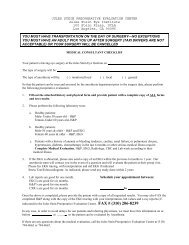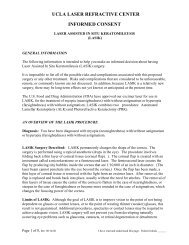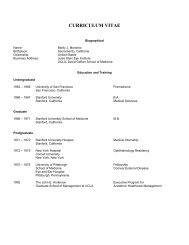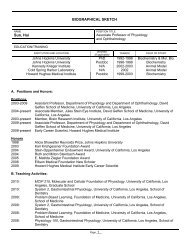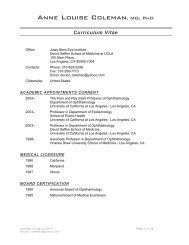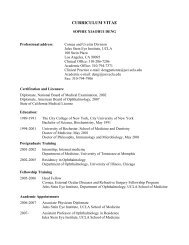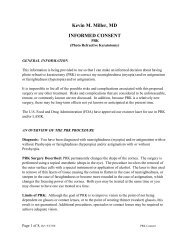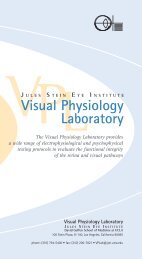View Annual Report - Jules Stein Eye Institute
View Annual Report - Jules Stein Eye Institute
View Annual Report - Jules Stein Eye Institute
Create successful ePaper yourself
Turn your PDF publications into a flip-book with our unique Google optimized e-Paper software.
antoni Ribas, mD<br />
Professor of Medicine, Surgery, and Molecular and<br />
Medical Pharmacology<br />
Member of the <strong>Jules</strong> <strong>Stein</strong> <strong>Eye</strong> <strong>Institute</strong><br />
ReseaRch summaRy<br />
The Immune System and<br />
Oncogene-Targeted Therapies<br />
in the Treatment of Cancer<br />
Dr. Antoni Ribas conducts research focused on melanoma,<br />
an aggressive form of skin and eye cancer. His<br />
research aims at developing more effective and less<br />
toxic therapies for patients with advanced melanoma<br />
by studying how the immune system can be effectively<br />
used to fight cancer and also how targeted therapies<br />
can specifically block cancer genes. His projects include<br />
laboratory and clinical translational research in adoptive<br />
cell transfer therapy using T-cell receptor engineered<br />
lymphocytes designed to seek out melanoma cells, with<br />
the application of molecular imaging and advanced<br />
monitoring of the immune system to better study how<br />
it can fight cancer. Another way to engage an anticancer<br />
immune response is through the use of immune<br />
modulating antibodies, in particular by releasing the<br />
immune breaks CTLA4 and PD-1. He is also testing,<br />
both in the laboratory and the clinic, novel targeted<br />
therapies blocking cancer-causing events that result in<br />
melanoma, as well as the potential clinical applications<br />
of nanoparticle delivery of siRNA, which interferes with<br />
gene expression related to cancer. Dr. Ribas’ goal is to<br />
bring new concepts from the laboratory to the clinic to<br />
help patients with advanced melanoma.<br />
Dario L. Ringach, PhD<br />
Professor of Neurobiology and Psychology,<br />
Biomedical Engineering Program<br />
Member of the <strong>Jules</strong> <strong>Stein</strong> <strong>Eye</strong> <strong>Institute</strong><br />
ReseaRch summaRy<br />
Visual Perception and Neurophysiology<br />
Dr. Ringach’s research focuses on the relationship<br />
between eye movements and visual perception, as well<br />
as how motor planning and execution, such as reaching,<br />
grasping, navigating, and adjusting body posture, is<br />
influenced by visual information and impaired vision.<br />
In collaboration with a team of neurosurgeons at UCLA,<br />
Dr. Ringach’s laboratory is also recording the brain<br />
activity of patients with epilepsy who are undergoing<br />
clinical evaluation for surgical treatment. This unique<br />
opportunity is shedding new light into the processes<br />
involved in object recognition and perception.<br />
Guido a. Zampighi, PhD<br />
Professor of Neurobiology<br />
Member of the <strong>Jules</strong> <strong>Stein</strong> <strong>Eye</strong> <strong>Institute</strong><br />
ReseaRch summaRy<br />
Intercellular Junctions<br />
and Communication<br />
A fundamental property of cells organized in tissues is<br />
their ability to communicate with each other via highly<br />
specialized areas of plasma membrane contact, called<br />
junctions. Dr. Zampighi is studying the gap junction and<br />
the chemical synapse, two specialized junctions that<br />
mediate electrical and chemical transmission, respectively.<br />
The gap junction is composed of specialized<br />
channels containing small hydrophilic pores that span<br />
the two plasma membranes and the intervening<br />
extracellular space (the cell-to-cell channel). He is<br />
investigating the high-resolution structure of the<br />
channels as well as the mechanisms of assembly,<br />
insertion, and retrieval of the connexin proteins that<br />
form them. The chemical synapse is composed of a<br />
presynaptic neuron filled with small diameter vesicles<br />
that contain a high concentration of neurotransmitters<br />
and a postsynaptic neuron with receptors. He is study-<br />
ing the mechanisms by which the synaptic vesicles<br />
attach (“dock”) to the presynaptic membrane. He uses<br />
structural (electron microscopy), biochemical, and<br />
electrophysiological techniques in an attempt to identify,<br />
purify, and characterize the channels and transporters of<br />
both junctions in an effort to increase understanding of<br />
the mechanisms mediating cell communication.<br />
Faculty 69



